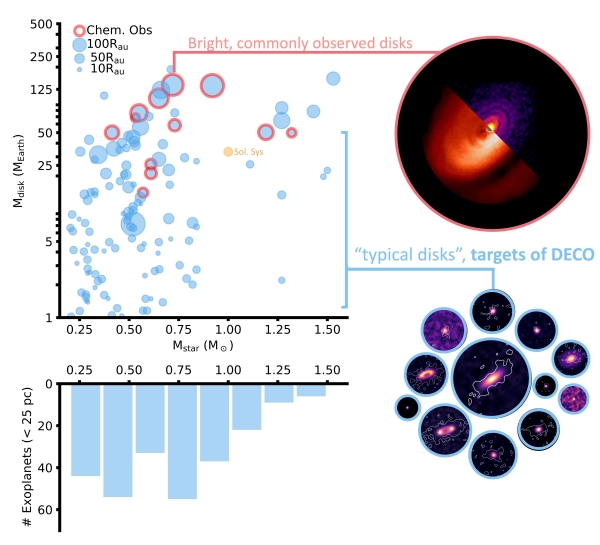Thesis Topic: The chemistry between disks and planets
Thesis Supervisor: Anna Miotello
Abstract
As of today, there are more than 5000 confirmed exoplanets, and yet understanding the formation process leading to the diversity of the observed planetary systems is still an open question. The next frontier in exoplanet science is now chemical characterisation. To date - roughly 20 giant planets have measured water abundances or Carbon-to-Oxygen (C/O) ratios and going forward, these measurements are a major priority. While the ultimate goal of studying exoplanet atmospheres is discovering extraterrestrial life, knowledge of atmospheric compositions can also allow us to place important constraints on planet formation. We know, in fact, that all planetary composition must originate from the dust, gas, and ice-rich protoplanetary disks.
The goal of the proposed PhD project is to bridge the gap between exoplanets and their birthplaces – protoplanetary disks — exploiting their chemical characterisation. This will be achieved using brand-new proprietary data from the ALMA Cycle 9 large program DECO (The Disk Exoplanet C/Onnection, PI: I. Cleeves; European co-PI: A. Miotello). With this programme, we are obtaining a large sample of observations of 80 disks, spanning different host star masses and disk sizes, designed to image molecular emission at high sensitivity. CO isotopologues, commonly used to trace the disk bulk properties, are being targeted as well as molecules whose abundances track C/O and metallicity (C/H and O/H), needed for calibrating CO-based gas masses. As the composition of the known exoplanets depends on the location of their formation and on its physical and chemical properties, it is crucial to match exoplanet atmospheric compositions with a more representative disk gas survey.
The PhD student will initially analyse the new CO isotopologue data from DECO to constrain the bulk disk properties such as radii, masses and surface density distributions and – together with the available information on the stellar parameter – put constraints on disk evolution theories. The PhD student will interpret the C/O ratios measured in the DECO disks by designing a grid of physical-chemical models with DALI (Dust And Lines – Bruderer et al. 2012; Miotello et al. 2014,2016,2019). Such models will aim to reproduce the observed hydrocarbon emission by varying the disk physical parameters derived in the first PhD project and unveil whether the emission of such molecule is mostly driven by the C/O ratio – as expected – or by properties like the disk radius or disk mass.
This project will allow the student to get acquainted with sub-mm interferometry, data reduction and analysis techniques. Furthermore, the student will gain experience in physical-chemical disk modelling and better understand the relevance of some physical (e.g., temperature, density) and chemical parameters (e.g., elemental abundances) in relation to molecular emission. Depending on the initial results from the DECO program and the student’s interests and creativity, the PhD project can take a more observational or modelling turn. Finally, an added value of this PhD project is that it will allow the student to be involved in a large international collaboration, such as DECO.

Figure Caption: The majority of disk gas studies have so far focused on a few massive disks, such as IM Lup (top right), which do not represent most planet formation environments. Most “typical” disks had very little gas data before DECO. These systems are far more representative of the known nearby exoplanet population (bottom left), and yet we know the least about them (Credit: I. Cleeves).

